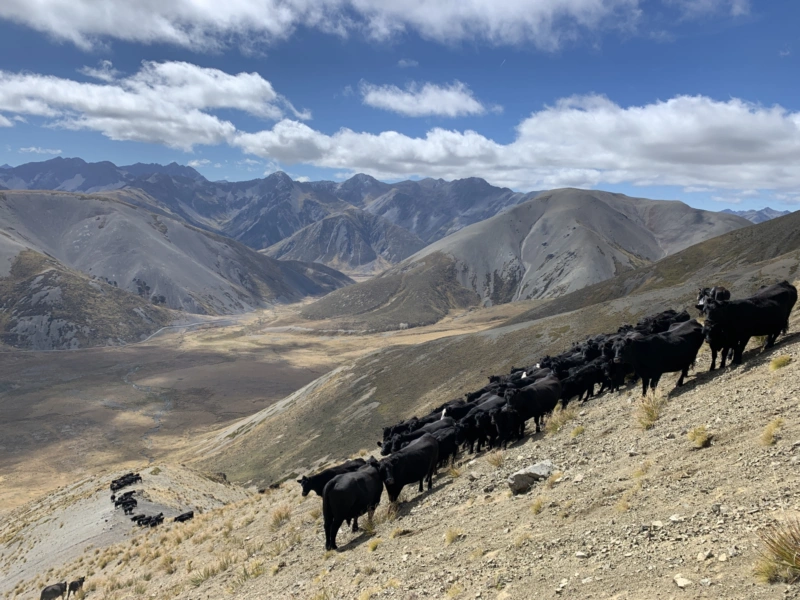Dairy beef means combining the dairy and beef farming approaches whilst leveraging our scale, farming, and genetics knowledge to produce and rear calves from dairy farms as meat animals. Dairy cows and beef or dairy sires are selected for genetic traits including robust growth, feed efficiency, and meat quality, coupled with short gestation and easy birthing. In parallel, systems from calf rearing to forage and finishing need to be reviewed and tailored to support the future of dairy beef.
What’s the story with dairy beef?
Pāmu is aiming to rear all calves born on its dairy farms by 2030. Dairy beef means calves are not processed as very young animals, but instead are raised for meat production.
How is this different to now?
Dairy and beef farming have evolved into quite different businesses in Aotearoa New Zealand, which means that a large percentage of calves born on dairy farms have traditionally not been reared for meat. Beef animals are different breeds selected for their eating quality. Currently, those calves not selected to go on and become replacement dairy cows are surplus to requirements. At Pāmu we are combining the two types of farming to increase efficiency and profitability. We also believe these farming system changes will contribute to our goals of reducing greenhouse gas emissions. We are collaborating with partners in industry and research, and sharing our learnings with farmers and rural professionals.
Genetics and systems expertise combined
Our increased understanding and expertise in genetics means we can develop animals with traits that will work for dairy cows (such as a short gestation and easy calving); and that also have the best meat animal attributes which include robust growth, feed efficiency, and great quality meat. Dairy beef as a concept is not new, and in Aotearoa New Zealand about 70% of total beef is estimated to originate from dairy - a mix of bobby calves, surplus heifers, bulls, and cull cows. Most bulls and cull cows finish up as manufacturing beef. The difference is that we are developing a new stock class, and putting systems into place, to make this farming change at a large scale across Aotearoa New Zealand and share our learnings with farmers across the country.

Where are we now?
Pāmu is currently raising 50% of the calves produced by our dairy herds. The next milestone is 75% raised by the end of FY26. We acknowledge that the final 20% will be the most challenging.
Aotearoa New Zealand dairy products are valued as most of our cows live outside and graze on grass, rather than indoors as in many other countries. One of the challenges of our more natural farming system is most calves are born in spring, and this means a lot of calves will need to be reared at the same time which means big changes to farm systems, and new skills to be developed, from calf rearing, to forage and finishing, to processing.
What are the reasons for moving to dairy beef?
As well as consumer demand, dairy beef has other advantages to both the dairy and beef industries:
- We can create a stock class with the best attributes of different breeds, apt for prime cuts and a lean manufacturing beef
- Reduction in livestock farms’ GHG emissions intensity / kg LWT
- Once bred-heifers that bring lighter animals onto hill country
- Reduces system duplication as beef farmers do not need to breed their own animals
- Transparent, traceable grass-fed beef from pasture to plate
- Improved animal welfare outcomes as we select for robust and easy to calve animals
- Jobs in the regions, calf rearing industry (new sharemilkers).
Current focus
Beef + Lamb New Zealand has been running dairy beef progeny tests for eight years, with the livestock running on Pāmu farms for the last five, and including experts from Focus Genetics, Massey and LIC.
Silver Stabilizers
Focus Genetics is establishing a Silver Stabilizers composite breeding programme in which a small nucleus herd of Stabilizer cows will have the Charolais coat colour dilution gene introgression to produce silver calves when used in dairy herds. Bulls from this nucleus will be multiplied out via Angus cow herds and the resulting unrecorded bull calves used as yearlings over dairy cows. This allows large numbers of bulls to be produced from a relatively small, recorded nucleus.




